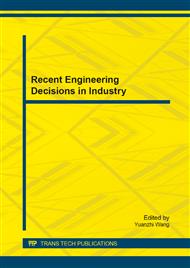[1]
E. Noel du Toit, L.W. Brian and K. Sang-Gook, Design considerations for MEMS-scale piezoelectric mechanical vibration energy harvesters, Integrated Ferroelectrics, vol71, pp.121-160.
DOI: 10.1080/10584580590964574
Google Scholar
[2]
S. P. Beeby, M. J. Tudor and N. M. White, Energy harvesting vibration sources for microsystems applications., Meas. Sci. Technol. 2006; 17: R175-R195.
DOI: 10.1088/0957-0233/17/12/r01
Google Scholar
[3]
S. Roundy, PK Wright, A Piezoelectric vibration basedgenerator for wireless electronics, Smart Mater. Struct., vol: 13, pp.1131-1142, (2004).
DOI: 10.1088/0964-1726/13/5/018
Google Scholar
[4]
F. Hua-Bin, L Jing-Quan, X Zheng-Yi, Lu D, W . Li and C . Di, Fabrication and performances of MEMS-based piezoelectric power generator for vibration energy harvesting, Microelectronics Journal., vol: 37, pp: 1280-1284, (2006).
DOI: 10.1088/0256-307x/23/3/057
Google Scholar
[5]
L. Jing-Quan, F. Hua-Bin, Xu. Zheng-Yi, M. Xin-Hui, Xiu-Cheng and Di Chen, A MEMS-based piezoelectric powergenerator array for vibration energy harvesting., Microelectronics Journal, vol: 39, pp.802-806, (2008).
Google Scholar
[6]
S. Dongna, P. Jung-Hyun, A . Jyoti, C. Song-Yul, C. W. Howard, K. Dong-Joo, The design, fabrication and evaluation of a MEMS PZT cantilever with an integrated Si proof mass for vibration energy harvesting., J. Micromech. Microeng., vol: 18, p.055017, (2008).
DOI: 10.1088/0960-1317/18/5/055017
Google Scholar
[7]
Fang Hua-Bin, Liu Jing-Quan, XuZheng-Yi, L. Dong, D. Chen and Cai Bing-Chu, A MEMS-based piezoelectric powergenerator for low frequency vibration energy harvesting., Chinese Phys. Lett., vol: 23, p.732, (2006).
DOI: 10.1088/0256-307x/23/3/057
Google Scholar
[8]
T. H. Lee, S Bhunia and M. Mehregany, Electromechanical computing at 500C with Silicon Carbide, Science, vol: 329, pp: 1316-1318, (2010).
DOI: 10.1126/science.1192511
Google Scholar
[9]
A. H. Epstein, Millimeter-scale, Micro-ElectroMechanical Systems gas turbine engines, ASME journal of Engineering for Gas Turbines and Power, vol: 126(2), pp: 204-226, (2006).
DOI: 10.1115/1.1739245
Google Scholar
[10]
G.W. Hunter, P.G. Neudeck and J. Xu, Developed of SiC-based gas sensors foraerospace applications, Material Research Society Symposium Proceeding, vol. 815, (2004).
Google Scholar
[11]
PM Sarro, Silicon Carbide as a new MEMS technology, Sensors and Actuators, vol: 82, pp: 210-218, (2008).
DOI: 10.1016/s0924-4247(99)00335-0
Google Scholar
[12]
J.M.R. Kudimi, F. Mohd-Yasin and S. Dimitrijev (2012), SiC-Based Piezoelectric Energy Harvester for Extreme Environment, 26th European Conference on Solid State Transducers, (Eurosensor XXVI), (2012).
DOI: 10.1016/j.proeng.2012.09.359
Google Scholar


